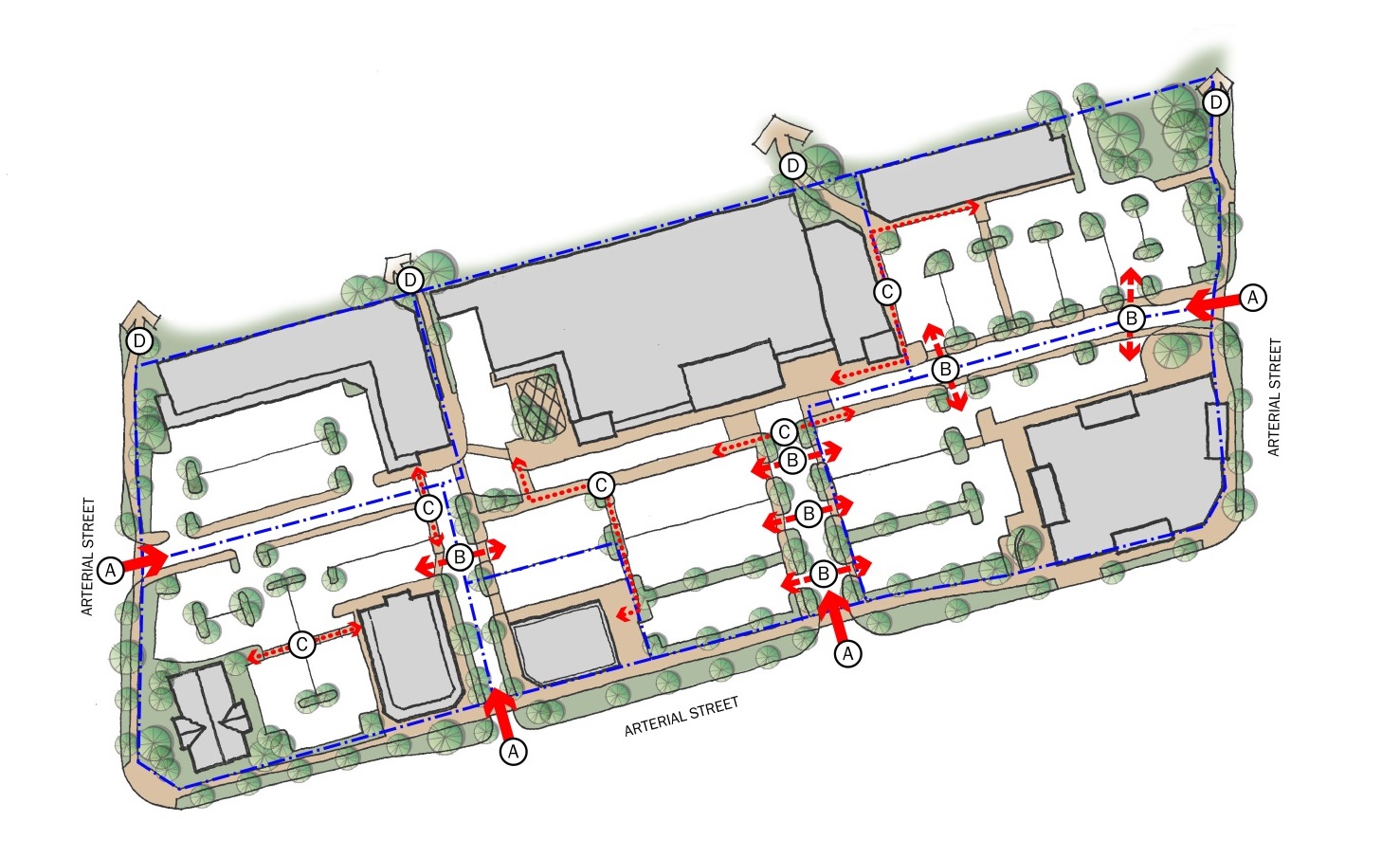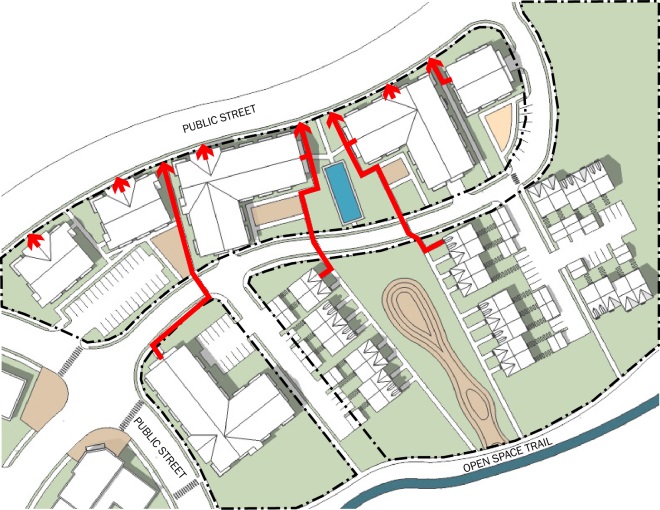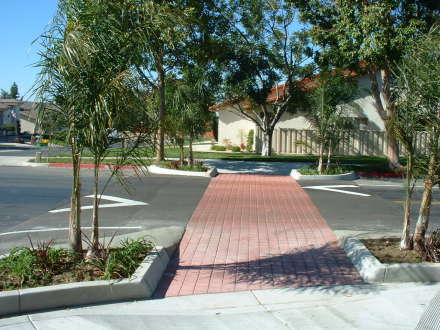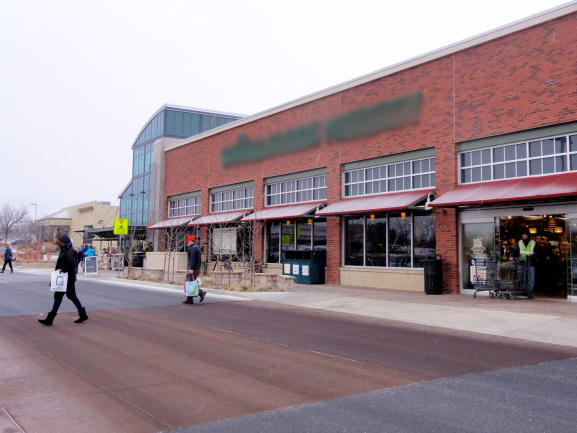4.5.4. ACCESS AND CONNECTIVITY ON INDIVIDUAL PLATTED LOTS.
The following standards apply to the design and layout of individual lots that are part of an approved subdivision. Each curb cut from private property onto a public or private street shall require City approval prior to construction.
A. Mixed-Use and Special Purpose Districts.
1. Vehicle Access. Access to Mixed-Use and Special Purpose district lots located on arterial streets shall provide site access meeting the requirements of Table 4.5-1 below, as illustrated in Figure 4.5-3 below.
|
Table 4.5-1 Mixed-Use and Special Purpose District Access from Arterials |
|
|---|---|
|
A |
Access points shall use flared or channelized intersections and be oriented at right angles to the street. |
|
B |
Curb cuts shall be located a minimum of 200 feet from each other and no more than the required number of curb cuts shall be used. For redevelopment sites, existing curb cuts may be used if approved by the Department of Public Works. |
|
C |
Vehicle entrances and exits shall be located at least 50 feet from any intersecting street right-of-way. |
|
D |
Vehicle entrances and exits shall be located at least 10 feet from an adjacent property line, except where it is possible to provide one shared access point to serve the adjacent property on the other side of that property line. |
|
E |
Primary circulation and access shall be oriented toward predominantly non-single-family residential streets. If necessary, secondary and emergency access may be provided on such streets. |
|
F |
Private full movement driveways giving access to development sites shall be aligned across arterial, collector and local streets to contribute to circulation efficiency. |
|
EXAMPLE |

|
|
GUIDELINE A – To the maximum extent practicable, combine access points for adjoining properties in order to minimize curb cuts and traffic impacts on adjoining streets. GUIDELINE B – Provide internal, direct vehicular connections between adjoining properties to reduce traffic impacts on adjoining streets. Align vehicular connections to the maximum extent practicable. A joint access agreement may be needed. GUIDELINE C – Provide internal pedestrian connections that link adjoining properties and create an internal pedestrian circulation system within large development sites. GUIDELINE D – Provide multiple pedestrian connections that link into existing or planned citywide open space and trail networks. |
|
Figure 4.5-3. Mixed-Use and Special Districts Access and Connectivity |
2. Vehicle Connectivity. Internal streets or driveways shall be made between multiple buildings and parking areas on a single lot or development to break up large parcels into smaller, internal “blocks”, and to avoid the need to use public boundary streets to move between different buildings or areas of the development site. Such connections shall:
a. Create internal “blocks” for which the perimeter of each “block” created by internal streets and external streets is no greater than 2,640 feet, or not greater than 1,600 feet for properties within ½ mile of an activity center or transit station.
b. Include a driving surface at least 16 feet wide.
c. Accommodate two-way traffic.
B. Additional Requirements for I-1,I-2, and AD Districts.
1. In Master Plans that include primarily industrial uses, the street layout shall generally align with the arterial and collector street system to the maximum extent practicable. Shared internal roadways and defined truck routes that avoid conflicts with primarily residential and commercial use areas shall be included to the maximum extent practicable.
2. Where an I-1, I-2, or AD zone district occurs along an arterial street frontage and residential use areas are located across the arterial street, entries serving the I-1 or I-2 district shall be placed out of alignment with residential use area entries to keep heavy commercial traffic out of residential neighborhoods.
3. No curb cut sized or designed for site access into an I-1, I-2, or AD zone district by a semi-truck tractor and/or trailer, or for site access by a commercial vehicle, trailer, or bus exceeding 6,000 pounds empty weight, shall be permitted on streets that separate R-1 or R-2 Residential zone districts from the I-1, I-2 or AD zone district.
4. In I-1, I-2, and AD zone districts, access and circulation shall be designed so that loading docks and loading dock door are internally oriented and are shared with adjacent industrial development in order to consolidate and minimize street access points, to the maximum extent practicable.
C. Residential Access. The provisions of this Section 146-4.5.4.C apply unless this UDO provides alternative access regulations for a specific residential land use or form of residential development, in which case those alternative standards shall apply.
1. Vehicle Access in General. Access from arterial streets into a residential development shall meet the requirements of Table 4.5-2 below.
|
Table 4.5-2 Residential District Access Standards |
|
|---|---|
|
A |
All residential units and associated parking spaces shall have direct vehicular access from a public street or alley or private street. |
|
B |
Vehicular access shall be from residential or side streets only, except that R-4 districts may have curb cuts from an arterial. |
|
C |
Vehicular access to multifamily developments shall be oriented toward non-residential streets rather than single-family neighborhood streets. |
|
D |
Vehicle access to residential lots from streets shall be located a minimum of 5 feet from each side property line. |
|
E |
Access driveways to residential development areas shall be a minimum of 23 feet and maximum of 30 feet in width for all residential uses except Motor Court Dwellings. |
|
F |
Curb cuts within a single property shall be minimized. |
2. Single-Family Residential Access Through Private Streets.
a. Indirect vehicular access from single-family detached dwellings to public streets may be provided by means of a private street, Loop Lane, or Motor Court, provided the standards in the Aurora Roadway Design and Construction Specifications Manual are met.
b. Alternative standards for Subarea C developments that incorporate Small Residential Lots are in Section 146-4.2.3.A (Subarea C Small Residential Lot Standards).
3. Individual Residential Driveways. Individual driveways from public streets to single-family detached or two-family residential dwelling shall comply with the standards of Section 146-4.6.5.C (Single-Family Detached and Two-Family Lots).
D. General Pedestrian Access and Connectivity.
1. Intent. These standards require that safe and convenient pedestrian access be provided to points within a development and to nearby uses and amenities to encourage walking and reduce the frequency and number of automobile trips.
2. Mixed-Use and Multifamily Districts. Each lot shall provide the following pedestrian connections, as applicable:
a. Required Connections are shown in Table 4.5-3.
|
Table 4.5-3 Required Pedestrian Connections |
|
|---|---|
|
From Main Entry to Public Sidewalk – Provide a safe, convenient, and accessible pedestrian connection from the main entrance of a building to a public sidewalk or internal walkway that connects to a public sidewalk. |

|
|
To Adjoining Streets – Provide pedestrian connections between internal and perimeter sidewalks at a maximum of 1,320 feet along the perimeter street (i.e. pedestrians along the perimeter sidewalks shall be able to find a sidewalk connection into the internal sidewalk system without walking more than 1,320 feet along the perimeter of such a site.) |

|
|
Between Multiple Buildings on a Site – All developments containing more than one building shall provide walkways between the principal entrances of buildings. |

|
|
To Adjacent Development – Sidewalks and walkways serving a site shall align and connect with any sidewalks on adjacent properties that extend to the boundary of such properties. Multiple pedestrian connections between adjacent developments shall be provided to the maximum extent practicable. |

|
b. Standards for Connections. Standards for connections are shown in Table 4.5-4.
|
Table 4.5-4 Pedestrian Crossing Options |
|
|---|---|
|
Change in Paving Materials |

|
|
Change in Paving Color |

|
i. Walkways shall be a minimum of six feet wide and include lighting at a height of 12 feet or less spaced no further than of 50 feet on center.
ii. Mixed-use and multifamily lots within one-quarter mile of a light rail transit station shall include a direct pedestrian connection to the station, to the maximum extent practicable, or if that is not practicable, to a public sidewalk leading to the station. Signage directing pedestrians to the nearest transit station shall be provided on-site.
iii. When a lot in a Mixed-Use district abuts public open space that includes existing or planned trails, a direct pedestrian connection at least six feet wide from the development to the existing or planned trail shall be provided.
iv. At each point where a sidewalk must cross a parking lot, internal street or driveway to make a required connection, it shall be clearly marked by using one of the methods shown in Table 4.5-3.
E. Americans with Disabilities Act.
1. All “places of public accommodation,” as defined in the federal Americans with Disabilities Act (42 U.S.C. 12101 et seq.) shall comply with the requirements of that Act concerning on-site circulation and access.
2. Accessible routes shall be provided from public transportation stops, accessible parking and accessible passenger loading zones and public sidewalks to 60 percent of the accessible building entrances they serve.
a. The accessible route between accessible parking and accessible building entrances shall be the most practical direct route. The accessible route must be located within a sidewalk, at least six feet wide, or as required to comply with the Aurora Roadway Design and Construction Specifications Manual, whichever is greater.
b. No slope along this route may exceed 1:20 without providing a ramp with a maximum slope of 1:12 and handrails.
c. Crosswalks along this route shall be wide enough to wholly contain the curb ramp with a minimum width of 36 inches and shall be painted with white stripes.
3. All development shall comply with handicapped accessibility requirements based on the version of the International Building Code, Chapter 11, and the International Code Council (ICC) A117.1-2009, or any future update of that document adopted by the City. (Ord. No. 2019-49 § 1, 08-19-2019)